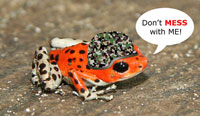By Kristin Van Alstine
Click image to enlarge This strawberry poison dart frog was called back for another tour. |
 Poison dart frog recon. |
 Ready for WAR!!! |
An amphibian that I have been interested in for quite some time is the poison dart frog. There are thousands of different species and varieties to choose from, they possess striking coloration and are fascinating to observe. I decided to take a suggestion from a reader, and focus this week’s blog on them, so this one’s for you, Ralph!
Poison dart frogs (or the animals formerly known as poison arrow frogs) can often be found in groups, congregating around bars or establishments that offer the sport of dart throwing. They are team players, often ganging up on unsuspecting tourists who don’t know what excellent marksmen they are. Not surprisingly, they frequently take the top prize in any dart tournament that they enter.
When not out having fun, elite members of a “special hops” counter-terrorism unit called the 31st Flying Frog Battalion are flown to conflict-stricken areas overseas, where they covertly parachute in under cover of night. They sport little helmets and backpacks containing essential supplies such as bottled water and energy bug bars. Once inside enemy territory, they pollute the water supply with their toxins and sneak back out unseen. This unit is comprised of battalion leader Lt. Stryker, weapons expert Sgt. Kane, communications specialist Pvt. Bishop, and sniper Col. Blackpool. When called into action, they get the job done.
In all seriousness, these frogs are just as spectacular in real life as they are in any fiction. They actually derive their names from the select species used by native peoples in Central and South America to coat the tips of arrows with their deadly toxin for hunting game. Another interesting fact is that the captive raised frogs are less toxic than their wild counterparts, because their toxicity is acquired from things in their environment like the ants and other insects that they eat in the jungle. They are also known for their extraordinary parenting skills, which are unparalleled in the herp world. Mother frogs will carry their tadpoles high into the tree canopy to tiny pools of water held by plants and then watch over them and bring them food. They are also being researched for possible breakthroughs in healthcare and applications in medicine.
These truly remarkable frogs are also at great risk for extinction as their habitat diminishes due to deforestation and as pollution takes its toll. Some day, captive breeding projects may be the last hope to keep these and many other species alive. I think that we should learn as much as possible about these majestic creatures and work harder to conserve their environment and our own. Although in captivity they require a somewhat elaborate setup, I would still like to keep them as pets some time in the future. But first, I’ll have to brush up on my dart skills and combat training!
-The Toad Talker


